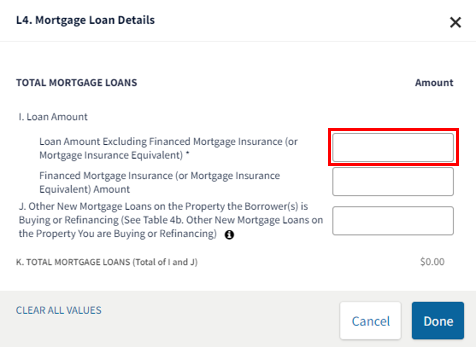My web
Construction-To-Permanent Transactions
![]()
This document explains the specific steps for entering data for construction-to-permanent transactions. This document is not intended to provide detailed instructions for entering all the loan application data in Desktop Underwriter® (DU®).
Construction-to-permanent financing can be structured as a transaction with one closing or a transaction with two separate closings. For information about how a construction-to-permanent transaction should be structured refer to the Selling Guide. Additional resources can be found on the Construction Products page.
You may scroll through this document, or click a link to be taken to the information for the specified topic:
Single-Closing Purchase
When a single-closing purchase transaction is used, the borrower is not the owner of the lot at the time of the first advance of interim construction financing, and the borrower is using the proceeds from the interim construction financing to purchase the lot and finance the construction of the property. Refer to the Selling Guide for additional information.
- On a single-closing construction-to-permanent purchase transaction, the lot should not be entered in the REO information, since the borrower does not yet own the lot. From the loan casefile you want to submit as a single-closing purchase transaction, navigate to the Real Estate Owned section to ensure there is no entry for the lot.
- Navigate to section 3. Real Estate Owned.
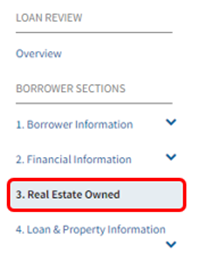
- Review Section 3: Real Estate Owned, to ensure there is no entry for the lot.
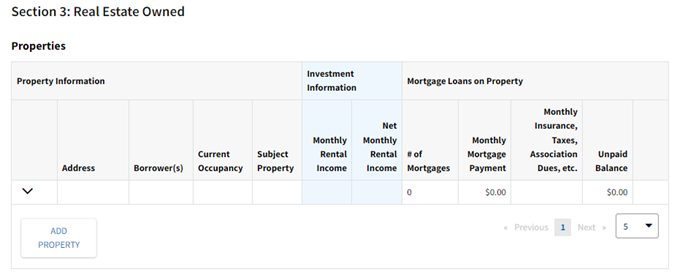
- Navigate to section 3. Real Estate Owned.
- Navigate to the Loan and Property Information screen.
- Click 4. Loan & Property Information in the navigation box.
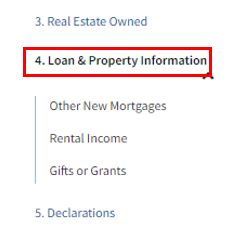
- Click the Edit icon on the 4a. Loan and Property Information screen.
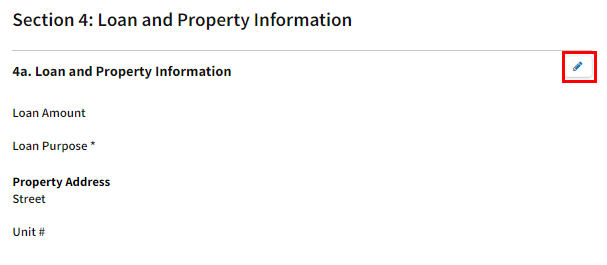
- Enter the loan and property information data associated with the transaction. Since this transaction will be structured as a single-closing purchase transaction, select Purchase in the Loan Purpose field. Enter the “as completed” appraised value of the property in the Appraised Property Value field. When you have finished entering the other applicable information, click Done.
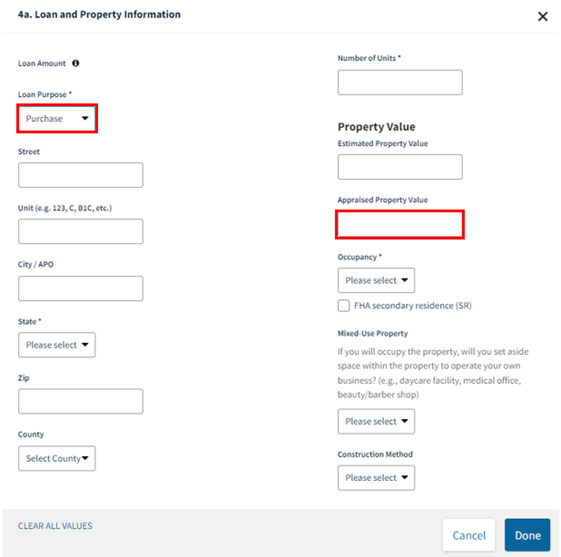
- Click 4. Loan & Property Information in the navigation box.
Note: The Loan Amount is displayed in section 4a. Loan and Property Information, but it is entered in section L4. Mortgage Loan Details.
- Navigate to the L1. Property and Loan Information screen.
- Click on L1. Property & Loan Information in the navigation bar.
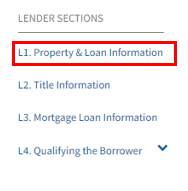
- Click the Edit icon on the L1. Property and Loan Information screen.
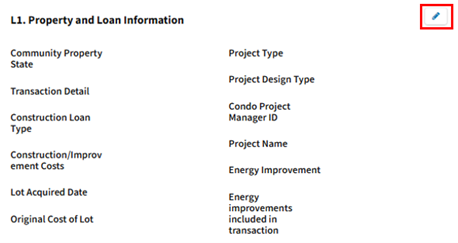
- Enter the property and loan information data associated with the transaction. Place a check mark in the Construction-to-Permanent field. A drop-down list will appear. Since this is a single-closing construction-to-permanent transaction, select Single-Closing from the drop-down list. Enter the cost of the construction in the Construction/Improvements Costs field. If the lot price and construction costs are on separate contracts, enter the cost of the lot in the Original Cost of Lot field. When you have finished entering the other applicable information, click Done.

- Click on L1. Property & Loan Information in the navigation bar.
- Navigate to the L4. Qualifying the Borrower section.
a. Click on L4. Qualifying the Borrower in the navigation bar.
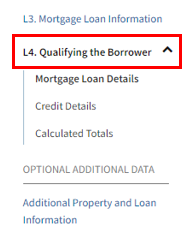
b. Click the Edit icon on the L4. Qualifying the Borrower screen.
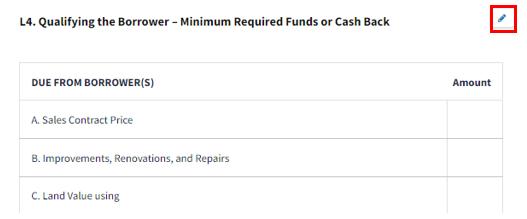
c. Complete the information on this screen according to the following:
- If the lot price and construction costs are on the same contract, enter the data according to the following:
- A. Sales Contract Price - Enter the full cost of the lot plus the cost of construction on Line A. Sales Contract Price.
- C. Land Value - Do not enter the cost of the lot on Line C. Land Value.
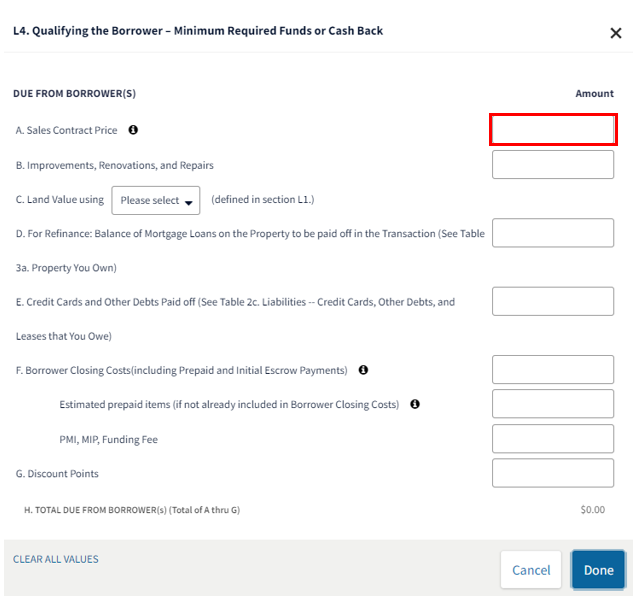
- If the lot price and construction costs are on separate contracts, enter the data according to the following:
- A. Sales Contract Price - Enter ONLY the cost of construction on Line A. Sales Contract Price.
- C. Land Value - Select Original Cost of Lot in the drop-down list to populate the lot value previously defined in section L1. Property and Loan Information.
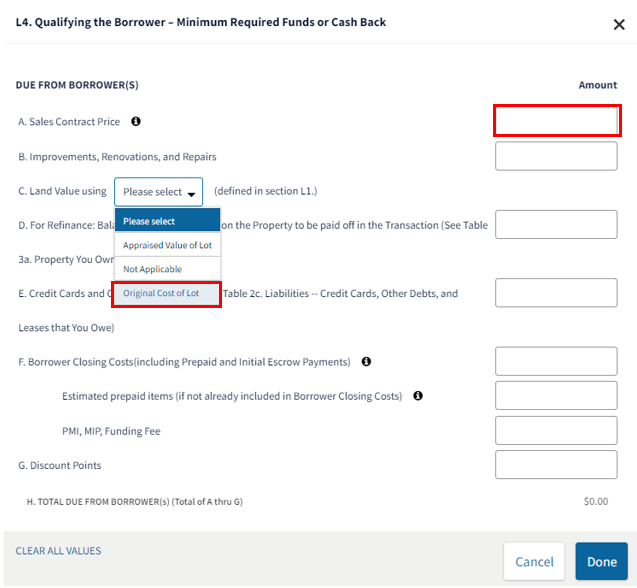
When you have finished entering the other applicable information, click Done.
Note: Do not enter an amount in the B. Improvements, Renovations, and Repairs field because that field should not be used for single-closing construction to permanent purchase transactions.
d. Next, scroll down to the L4. Mortgage Loan Details section and click the Edit icon.
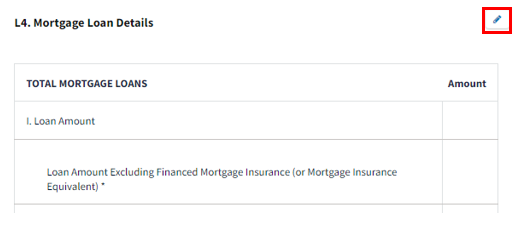
e. Enter the loan amount in the Loan Amount Excluding Financed Mortgage Insurance field.
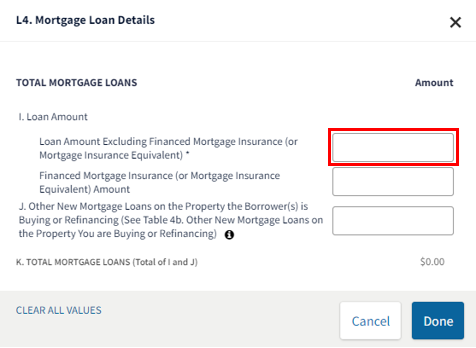
Single-Closing Refinance
When a single-closing limited cash-out refinance transaction is used, the borrower must have held legal title to the lot before they receive the first advance of interim construction financing. The borrower is using the proceeds from the construction financing to pay off any existing liens on the lot and finance the construction of the property. Refer to the Selling Guide for additional information.
- From the loan casefile you want to submit as a single-closing refinance transaction, enter the Real Estate Owned information.
- Navigate to section 3. Real Estate Owned.

- Click Add Property to create a record in the REO for the lot associated with the subject property.

- Click the Edit icon to enter the property information associated with the lot.
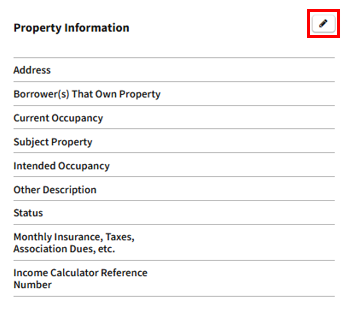
- Complete the property information associated with the lot. Ensure the subject property indicator is checked. Enter the estimated value of the lot in the Estimated Property Value field. Select Retained from the drop-down list in the Status field. When you have finished entering the other applicable information, click Done.
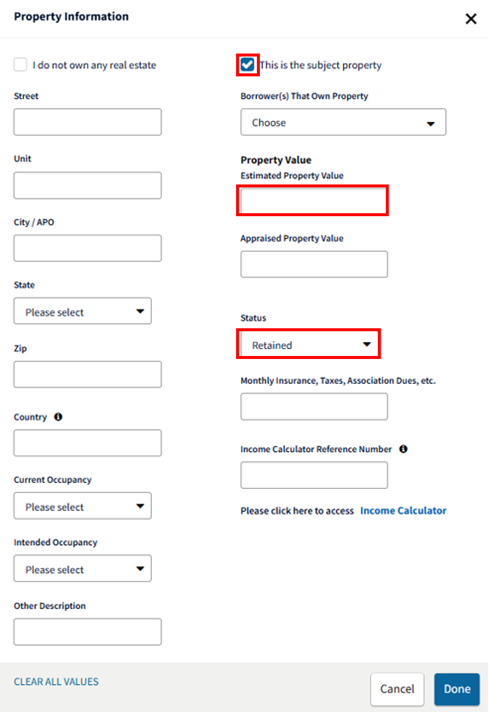
- Navigate to section 3. Real Estate Owned.
- If the borrower has any separate loans against the lot, you will need to associate the loan(s) against the lot to the corresponding REO record. If the borrower owns the lot free and clear (there are no existing loans against the lot), proceed to Step 3.
- Expand 2. Financial Information in the navigation bar and click Liabilities.
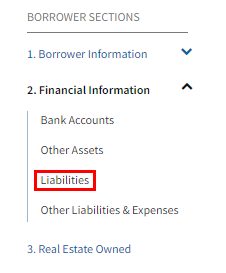
- In section 2c. Liabilities - Credit Cards, Other Debts, and Leases that You Owe click the Edit icon.

- For each outstanding loan against the lot, select the REO record for the lot from the REO Assignment field, and place a check mark in the To be paid off at or before closing field. When you have finished entering the other applicable information, click Done.
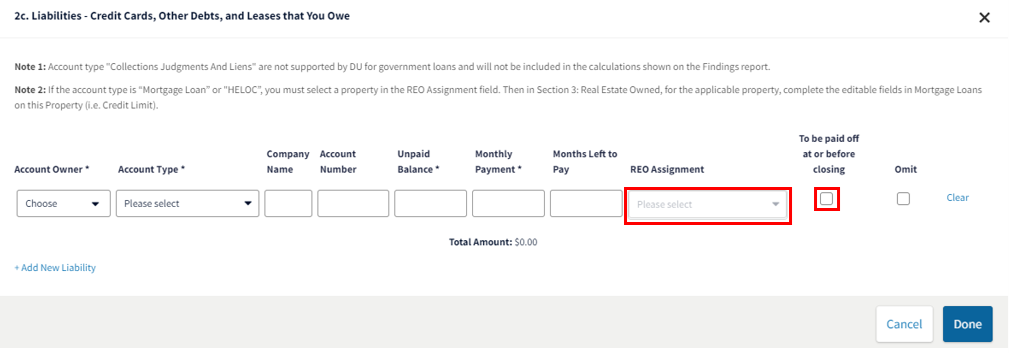
- Expand 2. Financial Information in the navigation bar and click Liabilities.
- Navigate to the Loan and Property Information screen.
- Click 4. Loan & Information in the navigation screen.
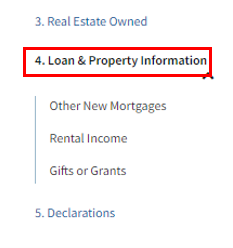
- Click the Edit icon on the 4a. Loan and Property Information screen.
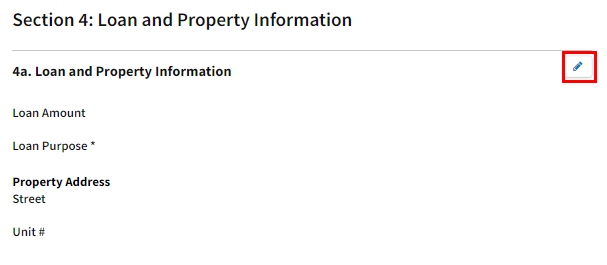
- Enter the loan and property information data associated with the transaction. Since this transaction will be structured as a single-close refinance transaction, select Refinancein the Loan Purpose field. When you do that, the Purpose of Refinance field will be displayed. Select Limited Cash Out from the drop-down list. Enter the “as completed” appraised value of the property in the Appraised Property Value field. When you have finished entering the other applicable information, click Done.
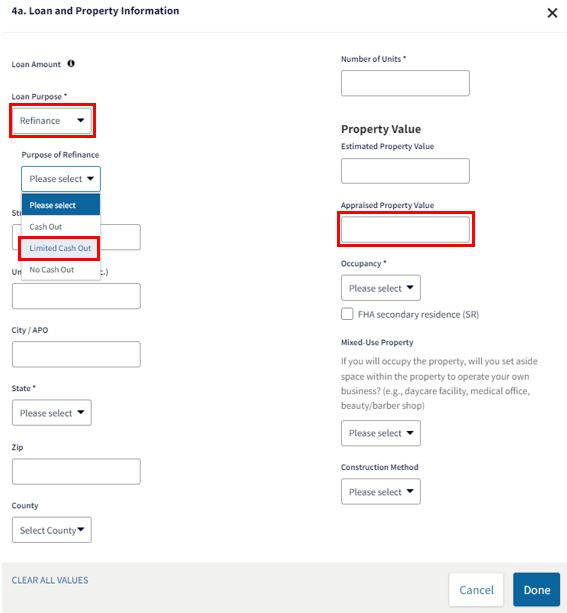
- Click 4. Loan & Information in the navigation screen.
Note: The Loan Amount is displayed in section 4a. Loan and Property Information, but it is entered in section L4. Mortgage Loan Details.
- Navigate to the L1. Property and Loan Information screen.
- Click on L1. Property & Loan Information in the navigation bar.
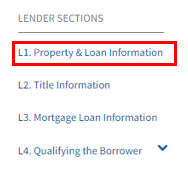
- Click the Edit icon on the L1. Property and Loan Information screen.
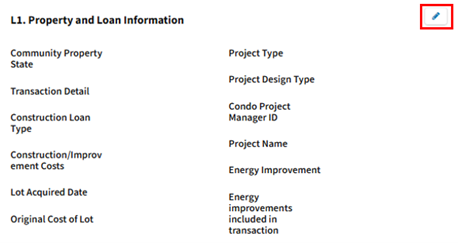
- Enter the property and loan information data associated with the transaction. Place a check mark in the Construction-to-Permanent field. A drop-down list will appear. Since this is a single-closing construction-to-permanent transaction select Single-Closing from the drop-down list. Enter the cost of the construction in the Construction/Improvement Costs field. When you have finished entering the other applicable information, click Done.

- Click on L1. Property & Loan Information in the navigation bar.
Note: On a construction-to-permanent refinance transaction the value of the lot should not be entered in the Original Cost of Lot field or Appraised Value of Lot field. If an amount is entered in either of these fields it will be included in required funds.
- Navigate to the L4. Qualifying the Borrower to section.
a. Click on L4. Qualifying the Borrower in the navigation bar.
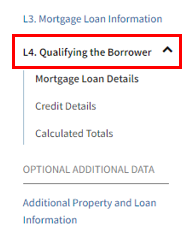
b. Click the Edit icon on the L4. Qualifying the Borrower screen.
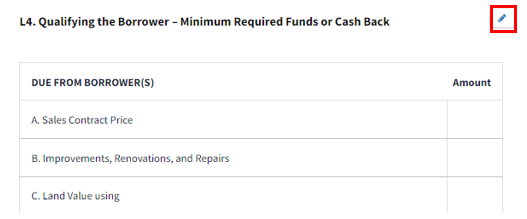
c. Complete the information on this screen according to the following:
- Line A. Sales Contract Price
- On a single-closing construction-to-permanent refinance transaction the cost of construction can be entered on either line A. Sales Contract Price or line B. Improvements, Renovations, and Repairs.
Note: Do not include the land value when entering the cost of construction on line A.
- Line B. Line B. Improvements, Renovations, and Repairs
- On a single-closing construction-to-permanent refinance transaction the cost of construction can be entered on either line A. Sales Contract Price or line B. Improvements, Renovations, and Repairs.
Note: Do not include the land value when entering the cost of construction on line B.
- Line D. Balance of Mortgage Loans on the Property to be paid off in the Transaction
- If the borrower has any separate loans against the lot that are being paid off with the transaction, enter the balance of the existing loan(s) on the lot. This amount should match the balance of the subject property mortgage(s) marked To be paid off at or before closing in section 2c.
- If the borrower owns the lot free and clear (there are no existing loans against the lot), do not enter a value on line D.
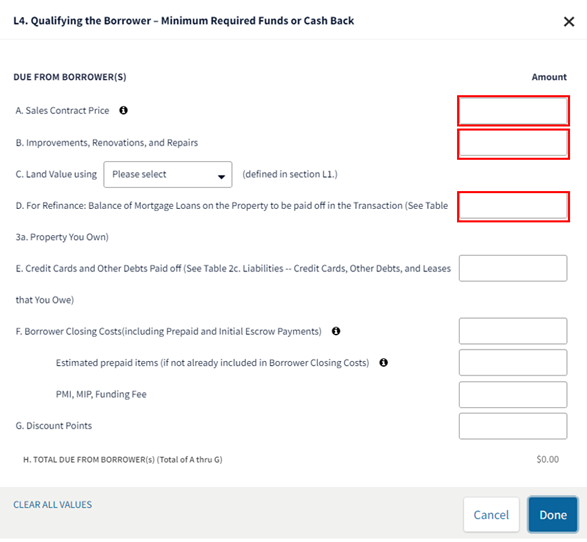
When you have finished entering the applicable information, click Done.
Note: Do not enter an amount in the C. Land Value field because that field should not be used for single-closing construction-to-permanent refinance transactions.
d. Next, scroll down to the L4. Mortgage Loan Details section and click the Edit icon.
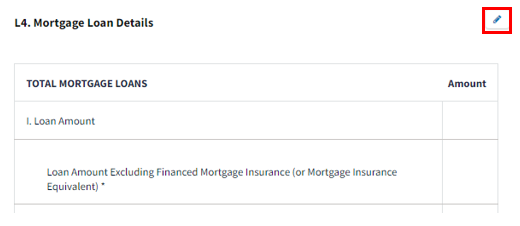
e. Enter the loan amount in the Loan Amount Excluding Financed Mortgage Insurance field.

Two-Closing Refinance
Two-closing construction-to-permanent mortgage transactions utilize two separate loan closings with two separate sets of legal documents. The first closing is to obtain the interim construction financing (and may include the purchase of the lot), and the second closing is to obtain the permanent financing upon completion of the improvements. Refer to the Selling Guide for additional information.
- From the loan casefile you want to submit as a two-closing refinance transaction, enter the Real Estate Owned information.
- Navigate to Section 3. Real Estate Owned.
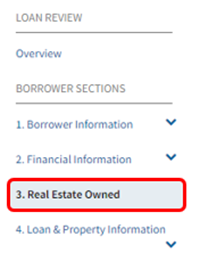
- Click Add Property to create a record in the REO for the subject property.
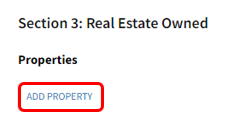
- Click the Edit icon to enter the property information associated with the lot.
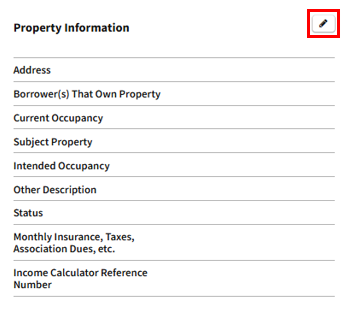
- Complete the property information associated with the subject property. Ensure the subject property indicator is checked. Enter the estimated property value of the completed property in the Estimated Property Value field. Select Retained from the drop-down list in the Status field. When you have finished entering the other applicable information, click Done.
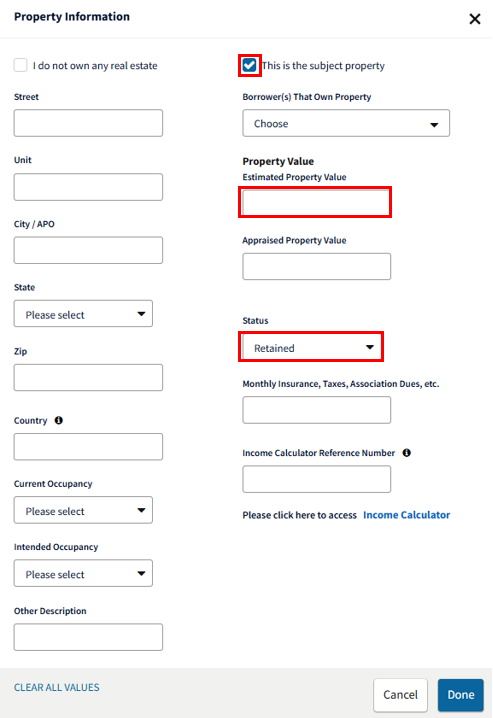
- Navigate to Section 3. Real Estate Owned.
- Next, you will need to associate the interim construction loan that is being refinanced, to the subject property REO record.
- Expand 2. Financial Information in the navigation bar and click Liabilities.
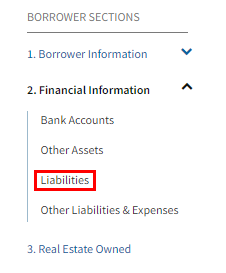
- In section 2c. Liabilities - Credit Cards, Other Debts, and Leases that You Owe click the Edit icon.

- For the interim construction loan(s), select the REO record for the subject property from the REO Assignment field, and place a check mark in the To be paid off at or before closing field. If there are any separate loans against the lot that are being paid off with the transaction, those should also be associated to the subject property using the REO Assignment field and marked To be paid off at or before closing. When you have finished entering the other applicable information, click Done.
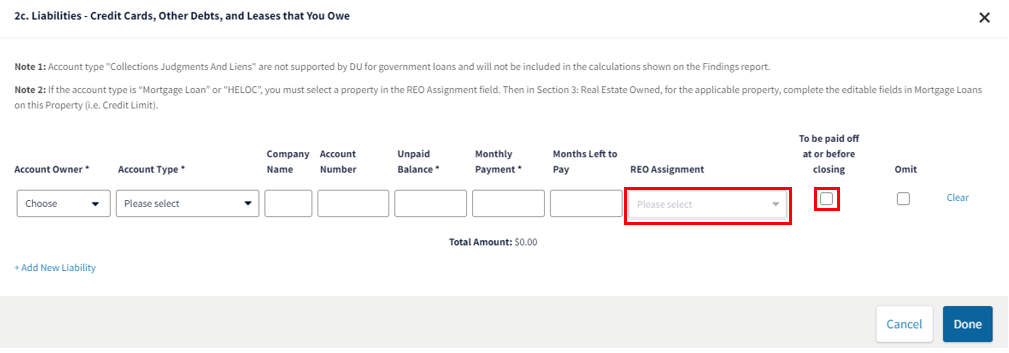
- Expand 2. Financial Information in the navigation bar and click Liabilities.
- Navigate to the Loan and Property Information screen.
- Click 4. Loan & Property Information in the navigation box.
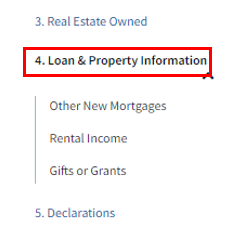
- Click the Edit icon on the 4a. Loan and Property Information screen.
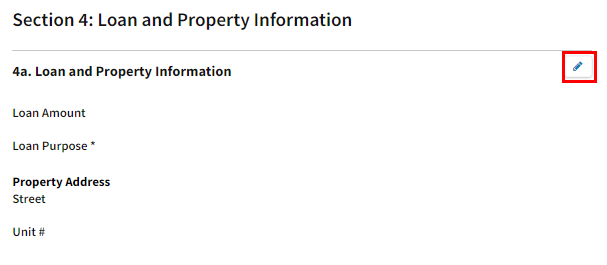
- Enter the loan and property information data associated with the transaction. Since this transaction will be structured as a two-closing refinance transaction, select Refinance in the Loan Purpose field. When you do that, the Purpose of Refinance field will be displayed. If this transaction will be closed as a cash-out refinance transaction, select Cash Out in the drop-down list. If the transaction will be closed as a limited cash-out refinance transaction, select Limited Cash Out from the drop-down list. Enter the “as completed” appraised value of the property in the Appraised Property Value field. When you have finished entering the other applicable information, click Done.
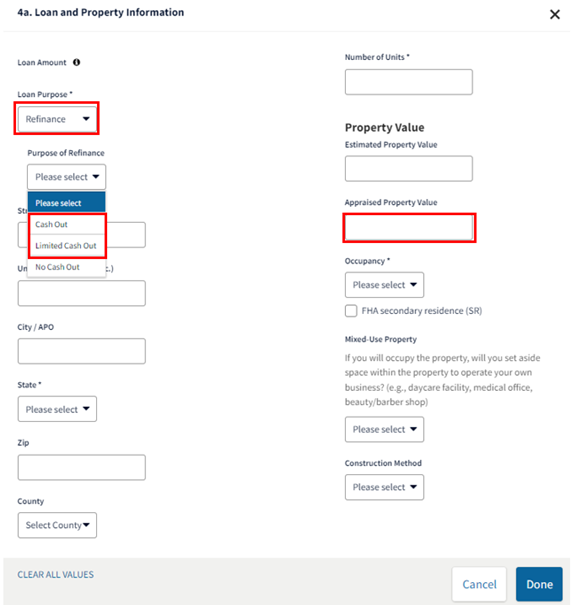
- Click 4. Loan & Property Information in the navigation box.
Note: The Loan Amount is displayed in section 4a. Loan and Property Information, but it is entered in section L.4 Mortgage Loan Details.
- Navigate to the L1. Property and Loan Information screen.
- Click on L1. Property & Loan Information in the navigation bar.
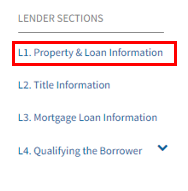
- Click the Edit icon on the L1. Property and Loan Information screen.
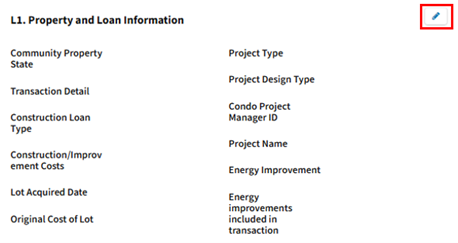
- Enter the property and loan information data associated with the transaction. Place a check mark in the Construction-to-Permanent field. A drop-down list will appear. Since this is a two-closing construction-to-permanent transaction, select Two-Closing from the drop-down list. Enter the cost of the construction in the Construction/Improvements Costs field. When you have finished entering the other applicable information, click Done.
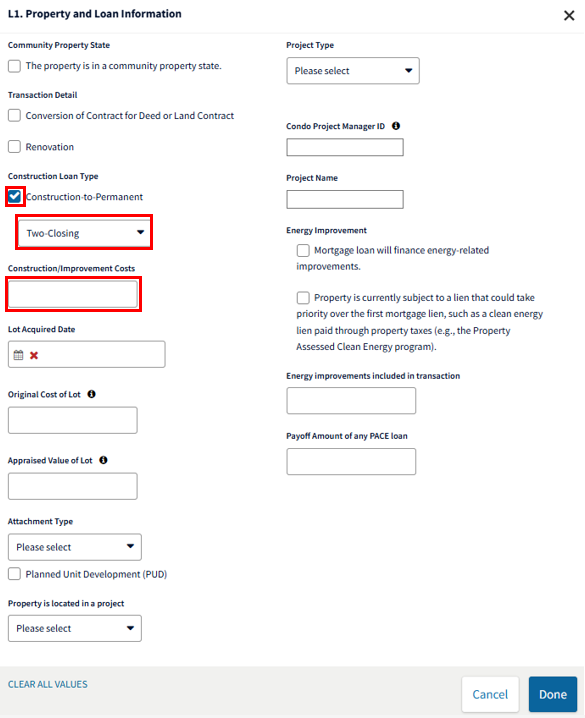
- Click on L1. Property & Loan Information in the navigation bar.
Note: On a construction-to-permanent refinance transaction the value of the lot should not be entered in the Original Cost of Lot field or Appraised Value of Lot field. If an amount is entered in either of these fields it will be included in required funds.
- Navigate to the L4. Qualifying the Borrower section.
a. Click on L4. Qualifying the Borrower in the navigation bar.
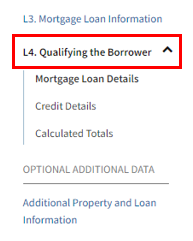
b. Click the Edit icon on the L4. Qualifying the Borrower screen.
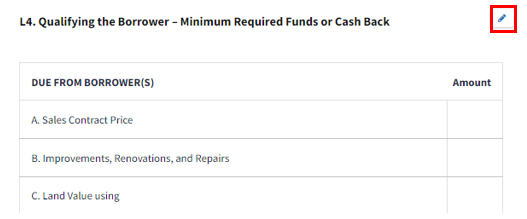
c. Complete the information on this screen according to the following:
• Line D. Balance of Mortgage Loans on the Property to be paid off in the Transaction – Enter the value of the interim construction loan(s) being paid off with the refinance transaction, and if applicable, any mortgage loans being paid off on the lot. This amount should match the balance of the subject property mortgage(s) marked To be paid off at or before closing in section 2c.
• Line F. Borrower Closing Costs - Contracted cost overruns on two-closing construction-to-permanent transactions that occurred outside of the interim construction loan should be included in the value(s) provided in the Borrower Closing Costs field.
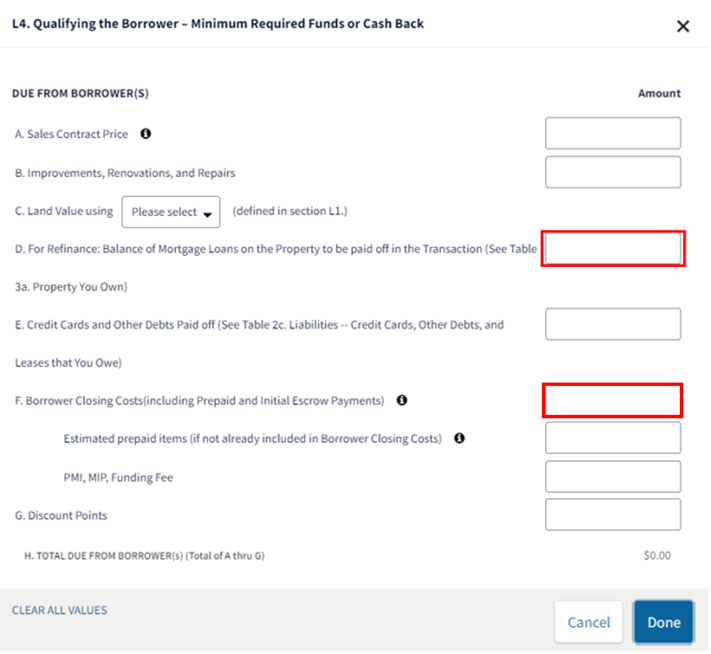
When you have finished entering the other applicable information, click Done.
Note: Do not enter an amount in the A. Sales Contract Price field, the B. Improvements, Renovations, and Repairs field, or the C. Land Value field because those fields should not be used for two-closing construction-to-permanent refinance transactions.
d. Next, scroll down to the L4. Mortgage Loan Details section and click the Edit icon.

e. Enter the loan amount in the Loan Amount Excluding Financed Mortgage Insurance field.
